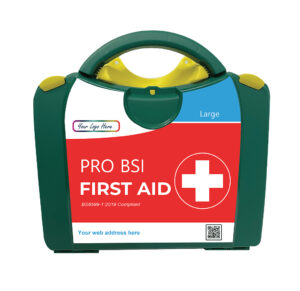BSI Kits – Sizes & Types: Selecting the Right First Aid Kit for Your Workplace
When carrying out a first aid needs assessment, it’s important to ask the right questions. Not only should you consider what type of incidents are most likely to happen, but you must also determine what first aid resources are required to respond effectively. At this stage, one of the key factors to examine is the range of BSI Kits – Sizes & Types available to support different risk levels and environments.
Start with a Clear Understanding of Risks
To begin with, assess past incidents. Were there common injuries like cuts or burns? Did your first aiders have what they needed when those incidents occurred? For instance, if staff frequently request plasters, it might be better to install a plaster station rather than have them opening main kits unnecessarily. Otherwise, blood contamination inside a full kit could require you to discard the entire contents.
Break Down the Types of Kits
Next, understand the different types of kits you can choose from. HSE kits offer a basic starting point and are suited for lower-risk environments. Catering kits, typically blue, are ideal for food prep areas. However, many workplaces prefer to invest in BSI Kits – Sizes & Types because they meet higher standards. These come in small, medium, and large versions—plus a separate travel-sized option for vehicles or mobile staff.
Factor in Layout and Staff Location
Moreover, you should think about your layout. In an office block, you might need one kit per floor. In a factory or large site, different departments may require different sizes or even specialist trauma kits. For example, high-risk zones should be equipped with tourniquets, haemostatic dressings, and trauma bandages in addition to the standard supplies.
Explore Customisation and Branding
In addition, you can personalise your kits. Some businesses choose to add QR codes linked to internal safety documents or instructional first aid videos. Others might prefer branded kits featuring their company logo or department names. These features not only improve access but also make training and compliance more engaging.
Mounting and Accessibility Considerations
Furthermore, consider how you’ll mount and store your kits. Wall brackets, hook systems, or soft-pouch cases offer different solutions depending on your space. No matter the style, your kit must remain visible and easy to access during an emergency.
Think Beyond the Minimum Requirements
Although guidance may recommend HSE kits as a minimum, upgrading to BSI versions ensures better preparedness. Beyond that, adding trauma kits shows you’re taking workplace safety seriously. These additions could make the difference between stabilising a casualty quickly or waiting helplessly for emergency responders.
Final Thoughts
Ultimately, your choice of first aid kits reflects your commitment to health and safety. By evaluating risk, reviewing layout, and selecting the right kit types, you provide real support when it’s needed most. From small plaster-only needs to serious injuries, there’s a kit that fits your business. For tailored recommendations, visit our website or contact our support team today.


Leave a Reply